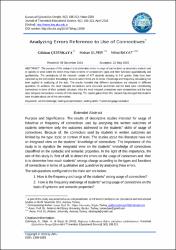| dc.contributor.author | Çetinkaya, Gökhan | |
| dc.contributor.author | Ülper, Hakan | |
| dc.contributor.author | Bayat, Nihat | |
| dc.date.accessioned | 2019-04-16T10:58:04Z | |
| dc.date.available | 2019-04-16T10:58:04Z | |
| dc.date.issued | 2016 | |
| dc.identifier.uri | http://dergipark.gov.tr/download/article-file/304321 | |
| dc.identifier.uri | http://hdl.handle.net/11630/5660 | |
| dc.description.abstract | Bu araştırmanın amacı ortaokul öğrencilerinin bağlayıcı kullanımlarındaki yanlışları saptamak ve yanlışların bağlayıcıların türüne ve işlevine göre ne düzeyde yapıldığını nicel ve nitel açıdan belirlemektir. Araştırmanın çalışma grubunu 5-8. sınıf düzeyinde öğrenimlerine devam eden 477 öğrenci oluşturmaktadır. Veriler 36 maddeden oluşan Bağlayıcı Bilgi Ölçeği ile toplanmıştır. Verilerin çözümlenmesinde yüzde ve frekans hesaplamalarına başvurulmuştur. Çözümlemeler sonucunda farklı bağlayıcıların farklı miktarlarda hatalı kullanıldığı, yapısal açıdan en fazla söylem belirteci türündeki bağlayıcılarda ve en az yana sıralama bağlayıcılarında, anlamsal açıdan ise en fazla karşıtlık bildiren bağlayıcılarda ve en az zamansallık bildiren bağlayıcılarda hata yapıldığı görülmüştür. Elde edilen bulgular öğrencilerin bağlayıcı kullanımlarında sorunlar yaşadığını ortaya koymuştur. | en_US |
| dc.description.abstract | The purpose of this research is to determine errors in usage of connectives by secondary students and to specify to what extent the errors they make in terms of connective’s types and their functions quantitatively and qualitatively. The participants of the research consist of 477 students studying in 5-8. grades. Data have been collected by the Connective Knowledge Scale in which there are 36 items. Percentage and frequency calculating has been applied in analyzing of the data. The results revealed that different connectives are misused in different quantities. In addition, the most misused connectives were discourse adverbials and the least were coordinating connectives in terms of their syntactic structure. Also the most misused connectives were comparisons and the least were temporal connectives in terms of their meaning. The results gained from this research has emerged that students have troubles about use of the connectives. | |
| dc.language.iso | tur | en_US |
| dc.identifier.doi | 10.5578/keg.10326 | en_US |
| dc.rights | info:eu-repo/semantics/openAccess | en_US |
| dc.subject | Sözcük Bilgisi | en_US |
| dc.subject | Okuduğunu Anlama | |
| dc.subject | Yazma Becerisi | |
| dc.subject | Türkçe Eğitimi | |
| dc.subject | Word Knowledge | |
| dc.subject | Reading Comprehension | |
| dc.subject | Writing Skills | |
| dc.subject | Turkish Language Education | |
| dc.title | Bağlayıcı kullanımına ilişkin yanlışların çözümlenmesi | en_US |
| dc.title.alternative | Analyzing errors reference to use of connectives | en_US |
| dc.type | article | en_US |
| dc.relation.journal | Kuramsal Eğitimbilim Dergisi | en_US |
| dc.department | Niğde Üniversitesi | en_US |
| dc.department | Burdur Mehmet Akif Ersoy Üniversitesi | |
| dc.department | Akdeniz Üniversitesi | |
| dc.identifier.volume | 9 | en_US |
| dc.identifier.startpage | 198 | en_US |
| dc.identifier.endpage | 213 | en_US |
| dc.identifier.issue | 2 | en_US |
| dc.relation.publicationcategory | Makale - Ulusal Hakemli Dergi - Kurum Yayını | en_US |



















